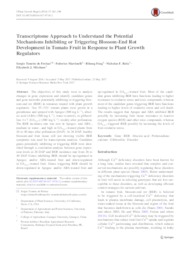Transcriptome approach to understand the potential mechanisms inhibiting or triggering blossom-end rot development in tomato fruit in response to plant growth regulators.
Transcriptome approach to understand the potential mechanisms inhibiting or triggering blossom-end rot development in tomato fruit in response to plant growth regulators.
Author(s): FREITAS, S. T. de; MARTINELLI, F.; FENG, B.; REITZ, N. F.; MITCHAM, E. J.
Summary: The objectives of this study were to analyze changes in gene expression and identify candidate genes and gene networks potentially inhibiting or triggering blossom-end rot (BER) in tomatoes treated with plant growth regulators. ?Ace 55 (Vf)? tomato plants were grown in a greenhouse and sprayed with Apogee (300 mg L?1), abscisic acid (ABA) (500 mg L?1), water (control), or gibberellins 4?+?7 (GA4?+?7) (300 mg L?1) weekly after pollination. The BER incidence rate was zero in Apogee- and ABA-, medium in water-, and high in GA4?+?7-treated plants from 26 to 40 days after pollination (DAP). At 26 DAP, healthy blossom-end fruit tissue still not showing visible BER symptoms was used for transcriptome analysis. Candidate genes potentially inhibiting or triggering BER were identified through a correlation analysis between gene expression levels at 26 DAP and BER incidence rate from 26 to 40 DAP. Genes inhibiting BER should be up-regulated in Apogee- and/or ABA-treated fruit and down-regulated in GA4?+?7-treated fruit. Genes triggering BER should be down-regulated in Apogee- and/or ABA-treated fruit and up-regulated in GA4?+?7-treated fruit. Most of the candidate genes inhibiting BER have functions leading to higher resistance to oxidative stress and toxic compounds, whereas most of the candidate genes triggering BER have functions leading to higher levels of oxidative stress and cell death. The results suggest that Apogee and ABA inhibited BER possibly by increasing fruit tissue resistance to reactive oxygen species (ROS) and other toxic compounds, whereas GA4?+?7 triggered BER possibly by increasing the levels of fruit oxidative stress.
Publication year: 2017
Types of publication: Journal article
Unit: Embrapa Semi-arid Region
Observation
Some of Embrapa's publications are published as ePub files. To read them, use or download one of the following free software options to your computer or mobile device. Android: Google Play Books; IOS: iBooks; Windows and Linux: Calibre.
Access other publications
Access the Agricultural Research Database (BDPA) to consult Embrapa's full library collection and records.
Visit Embrapa Bookstore to purchase books and other publications sold by Embrapa.

